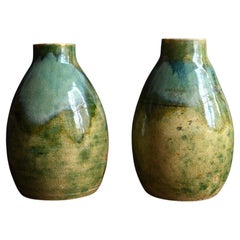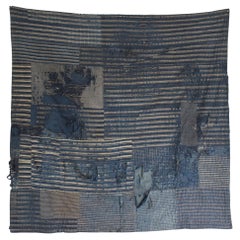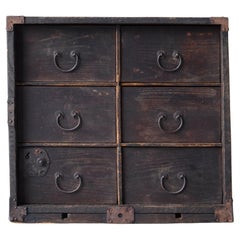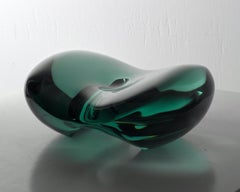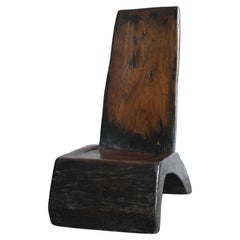Japan
to
558
1,008,557
701,914
2,233
1,604
908
527
468
399
334
176
138
119
109
95
94
80
61
49
49
46
42
42
26
21
13
11
10
8
8
7
7
6
5
5
5
5
4
3
3
2
2
2
1
1
1
1
1
1
1
289
201
65
58
46
Japanese Antique Large Tansu 1860s-1900s / Cabinet Cupboard Wabi Sabi
Located in Chōsei District Nagara, JP
This is an old, large Tansu made in Japan. It is an unusual style with a vertical structure, and is thought to have been made during the Meiji period (1860s-1900s). Unlike most horiz...
Category
Early 20th Century Japanese Meiji Japan
Materials
Cedar
Set of two small Japanese antique pottery vases/Made in 1804/Mino ware
Located in Sammu-shi, Chiba
This is a pair of small Mino ware flower vases, believed to have been crafted in the late Edo period, specifically in the first year of the Bunka era (1804). The inside of the wooden...
Category
Early 19th Century Japanese Edo Antique Japan
Materials
Pottery
Japanese Antique "BORO" 1800s-1860s / Rag Tapestry Patchwork Textile Wabisabi
Located in Chōsei District Nagara, JP
This is an old Japanese BORO. It was made in the late Edo period (1800s-1860s) and is an extremely valuable piece that has been carefully passed down to the present day.
BORO" is a ...
Category
Mid-19th Century Japanese Edo Antique Japan
Materials
Fabric
Japanese Antique Small Drawer 1860s-1900s / Nightstand Tansu Wabi Sabi
Located in Chōsei District Nagara, JP
This is an old small drawer storage made in Japan. The furniture was made during the Meiji period (1860s-1900s), and the texture of the wood over the years gives it a deep flavor. Th...
Category
Early 20th Century Japanese Meiji Japan
Materials
Iron
F.171201 by Toshio Iezumi - Contemporary glass sculpture, green, abstract, light
By Toshio Iezumi
Located in Paris, FR
F.171201 is a glass sculpture by Japanese contemporary artist Toshio Iezumi, dimensions are 17 × 42 × 35 cm (6.7 × 16.5 × 13.8 in).
The sculpture is signed and numbered, it is part ...
Category
2010s Contemporary Japan
Materials
Glass
Old wooden low chair from Southeast Asia/Modern design chair
Located in Sammu-shi, Chiba
This is a wooden low chair, believed to have been made in a region such as Southeast Asia. With its tall backrest and low seat height, it pairs beautifully with floor-level tables or...
Category
20th Century Indonesian Other Japan
Materials
Wood
Japanese Antique Side Chair or Side Table 1860s-1900s / Stool Wabisabi Mingei
Located in Chōsei District Nagara, JP
This is an old side chair made in Japan. It was made during the Meiji period (1860s-1900s) and is made of cedar wood.
The trapezoidal shape is characteristic of this piece, and its ...
Category
Early 20th Century Japanese Meiji Japan
Materials
Cedar
Ararat Rugs Oversized Mamlouk Rug A Majestic Revival of Islamic Artistry Carpet
By Ararat Rugs
Located in Tokyo, JP
Origin and Inspiration:
The Mamlouk Rug is a contemporary masterpiece that draws its inspiration from the rich textile traditions of the Mamlouk Sultanate, which reigned over Egypt a...
Category
21st Century and Contemporary Turkish Revival Japan
Materials
Wool, Natural Fiber, Organic Material
Japanese Antique Black Drawer Storage 1860s-1900s / Tansu Sideboard Wabi Sabi
Located in Chōsei District Nagara, JP
This is a black drawer storage made in Japan.
This furniture was made in the Meiji period (1860s-1900s) and is made of cedar wood. Cedar is lightweight yet strong, and was widely use...
Category
Early 20th Century Japanese Meiji Japan
Materials
Iron
Ararat Rugs Anatolian Medallion Carpet, 16th Century Revival Rug Natural Dyed
By Ararat Rugs
Located in Tokyo, JP
The source of the carpet comes from the book Orient Star - A Carpet Collection, E. Heinrich Kirchheim, Hali Publications Ltd, 1993 nr.178. This is an unusual border drawing, a medall...
Category
21st Century and Contemporary Turkish Oushak Japan
Materials
Wool, Natural Fiber, Organic Material
17th Century Japanese Screen. Cranes and Peonies. Edo period.
Located in Kyoto, JP
Cranes and Peonies
Anonymous, Kano School.
Edo period, second half of the 17th century.
Six-panel Japanese screen. Ink, pigment gofun and gold leaf on paper.
This Japanese screen...
Category
Mid-17th Century Japanese Edo Antique Japan
Materials
Gold Leaf
Japanese Antique Large Low Table with Japanese Paper Base /SofaTable /Wabi-Sabi
Located in Iwate-gun Shizukuishi-cho, Iwate Prefecture
This is a large low table made from old Japanese wood.
The tabletop is a very large, heavy board. Over the years, the surface has changed to a natural, primitive look. Its use is un...
Category
Late 19th Century Japanese Primitive Antique Japan
Materials
Hardwood, Paper
Japanese Antique Small Door Wall Decoration 1860s-1900s / Abstract Art Wabi Sabi
Located in Chōsei District Nagara, JP
This is an old small window frame made in Japan. It was originally used as a traditional Japanese mud wall fixture. It dates back to the Meiji period (1860s-1900s) and has been in us...
Category
Early 20th Century Japanese Meiji Japan
Materials
Bamboo, Cedar
Japanese Antique Black Cabinet / Japanese Bandaji / 1800-1860s / Wabi-Sabi
Located in Iwate-gun Shizukuishi-cho, Iwate Prefecture
This is a storage furniture used in the countryside of Japan.
The main material is cedar, and it was used in the Tohoku region.
It was probably made as storage furniture for grains a...
Category
19th Century Japanese Edo Antique Japan
Materials
Wood, Cedar, Straw
Kaj Franck / KF2 HORS D'OEUVRE DISH(BROWN) / Arabia Finland
By Arabia of Finland, Kaj Franck
Located in Shibuya-Ku, JP
KF2 was designed in 1957 and manufactured from 1958 to 1962.
A geometric-shaped appetiser dish. One of Kai Franck's masterpieces, combining structural beauty with functional elegance...
Category
1950s Finnish Scandinavian Modern Vintage Japan
Materials
Ceramic
Japanese antique small wooden storage shelf / Early 20th century
Located in Sammu-shi, Chiba
This compact yet finely crafted piece of furniture was made in Japan in the early 20th century. Likely constructed from aged cedar or cypress, the wood has developed a rich patina ov...
Category
Early 20th Century Japanese Taisho Japan
Materials
Cedar
Circa 1900 Japanese Pine Screen Pair. Aged Dragons by Suzuki Shonen.
Located in Kyoto, JP
Suzuki Shonen (1848-1918)
Aged Dragons
A pair of six-panel Japanese screens. Ink and gold leaf on paper.
Dimensions: Each Screen: H. 170 cm x 378 cm (67" x 149")
As with the pair...
Category
Early 20th Century Japanese Meiji Japan
Materials
Gold Leaf
Japanese Antique Artillery Shell 1900s-1920s / Iron Ball Object Wabisabi
Located in Chōsei District Nagara, JP
This is an old Japanese artillery shell.
From its appearance, it is assumed that it is an iron shell for artillery.
Considering the size, shape, and rusty condition of this iron ball...
Category
1910s Japanese Showa Vintage Japan
Materials
Iron
Early 20th Century Japanese Screen. Flowers of the Four Seasons.
Located in Kyoto, JP
Anonymous
Flowers of the Four Seasons
A four-panel Japanese screen. Ink, gofun and pigments on gold leaf.
This Japanese screen is a rich visual celebration of the flowers of the fo...
Category
Early 20th Century Japanese Taisho Japan
Materials
Gold Leaf
Old Japanese wooden low table/wooden bench/Showa era/feed trough
Located in Sammu-shi, Chiba
This is an old Japanese wooden feeding trough (kaiba-oke) made around the 20th century. It is crafted from cedar wood, a material well-suited to Japan’s natural climate, and its dist...
Category
20th Century Japanese Showa Japan
Materials
Cedar
Japanese Antique Large Black Display Table 1900s-1920s / Side Table Wabisabi
Located in Chōsei District Nagara, JP
This is a large display table made in Japan. It is constructed of old wood used during the Meiji and Taisho periods (1900s-1920s), and the material used is cedar. The top and legs ar...
Category
Early 1900s Japanese Primitive Antique Japan
Materials
Cedar
Japanese Antique Cabinet 1860s-1920s / Tansu Sideboard Wabisabi
Located in Chōsei District Nagara, JP
This is an old storage cabinet made in Japan.
It is a piece of furniture made between the Meiji and Taisho periods (1860s-1920s), and it is a piece of furniture that has passed throu...
Category
Early 20th Century Japanese Taisho Japan
Materials
Iron
Japanese Antique Chest of Drawers 1860s-1900s / Tansu Nightstand Wabi Sabi
Located in Chōsei District Nagara, JP
This is an old drawer storage made in Japan.
This furniture was made during the Meiji period (1860s-1900s) and is a valuable piece of furniture that has transcended time and remains ...
Category
Early 20th Century Japanese Meiji Japan
Materials
Iron
Japanese Antique Tansu 1860s-1900s / Sideboard Cabinet Wabi Sabi
Located in Chōsei District Nagara, JP
This is an old Tansu made in Japan.
It was made during the Meiji period (1860s-1900s), and the material used is rustic and warm cedar wood. It is a piece that embodies the functional...
Category
Early 20th Century Japanese Meiji Japan
Materials
Cedar
Antique wall-hanging vase made from Japanese bamboo/River fishing equipment
Located in Sammu-shi, Chiba
This is a traditional Japanese fishing implement called an "uke," crafted from bamboo during the Meiji to early Showa period. It was placed in rivers to trap eels and loaches, which,...
Category
Late 19th Century Japanese Taisho Antique Japan
Materials
Bamboo
Japanese Antique Large Tansu / Cabinet Cupboard / 1868-1912s Wabi-sabi
Located in Iwate-gun Shizukuishi-cho, Iwate Prefecture
This is an old Japanese tansu.
It was used in the Tohoku region around the Meiji period, and the main material is pine wood.
It is believed to have originally been used as a cupboa...
Category
Late 19th Century Japanese Meiji Antique Japan
Materials
Wood, Cedar, Chestnut, Pine
Japanese Antique Wooden Box / Side Table Sofa Table / 1868-1912s Wabi-sabi
Located in Iwate-gun Shizukuishi-cho, Iwate Prefecture
This is an old wooden box made in Japan.
It is thought to date from around the Meiji period and is made of cherry wood.
It is one of the folk tools used in early modern Japan, and ...
Category
Late 19th Century Japanese Meiji Antique Japan
Materials
Wood, Cherry
Saara Hopea / "BUBBLE" VASE SH122 / Nuutajärvi
By Nuutajärvi Notsjõ, Saara Hopea-Untracht
Located in Shibuya-Ku, JP
Saara Hopea is a Finnish female designer.
She specialised in interior design at the Central School of Applied Arts in Helsinki, and after graduating, she started her career as a furn...
Category
1950s Finnish Scandinavian Modern Vintage Japan
Materials
Blown Glass
Ararat Rugs the Barbieri Tree Design Carpet, Persian Revival Rug, Natural Dyed
By Ararat Rugs
Located in Tokyo, JP
The source of carpet comes from the book Orient Star - A Carpet Collection, E. Heinrich Kirchheim, Hali Publications Ltd, 1993 nr.64 and Islamic Carpets, Joseph V. McMullan, Near Eas...
Category
21st Century and Contemporary Turkish Revival Japan
Materials
Wool, Natural Fiber, Organic Material
1860s-1910s Japanese antique wabi sabi Black Urushi mid Tansu chest of drawers
Located in 常陸大宮市, JP
From Hokuriku area, Japan.
This tansu chest of drawers seemed to be in the vein of Kusuri dansu (Medicine / apothecary chest).
Product of Meiji era (1860s-1910), estimate from the ...
Category
Late 19th Century Japanese Meiji Antique Japan
Materials
Wood, Cedar
Japanese Antique Black Drawer / Storage Tansu / 1905s / Wabi-Sabi Mingei
Located in Iwate-gun Shizukuishi-cho, Iwate Prefecture
This is an old Japanese-made drawer.
It is made of cedar wood, and on the bottom of the drawer there is a mark with the date "Meiji 38 (1905)" written in ink from that time.
After ...
Category
Early 1900s Japanese Meiji Antique Japan
Materials
Iron
Japanese Antique Drawer 1860s-1920s / Sideboard Wabi Sabi
Located in Sammu-shi, Chiba
This is a very old drawer storage chest made in Japan.
It dates back to the Meiji era (1860s–1920s) and is crafted from Japanese cedar wood.
The metal fittings are made of iron.
The...
Category
Early 20th Century Japanese Meiji Japan
Materials
Iron
Japanese antique large wooden low table/1868-1920/long table/Mingei
Located in Sammu-shi, Chiba
A large low table made in Japan from the Meiji to the early Taisho period (1868-1920).
Originally, it seems that it was a work table for sitting and doing some work.
There are countl...
Category
Late 19th Century Japanese Meiji Antique Japan
Materials
Cedar
Set of Japanese Old Octagon Wood Stools 1940s-1960s / Side Table Stool Wabisabi
Located in Sammu-shi, Chiba
This is a vintage octagonal stool crafted in Japan,
dating from the Taisho to early Showa period (1940s–1960s).
Made from KIRI (Paulownia wood), a traditional material cherished in J...
Category
Mid-20th Century Japanese Showa Japan
Materials
Wood
Japanese Antique Tansu Cabinet 1860s-1920s / Cabinet Sideboard Wabi-Sabi
Located in Sammu-shi, Chiba
This is a medium-sized antique Japanese chest, crafted in Japan during the Meiji period (1860s–1920s).
Made entirely from solid cedar wood, it speaks quietly of its origins, yet with...
Category
Early 20th Century Japanese Meiji Japan
Materials
Cedar
Japanese Black Tansu 1920-1940 / Showa Period / Cabinet Sideboard Wabi sabi /
Located in Sammu-shi, Chiba
This is a traditional Japanese mizuya tansu believed to have been crafted between the Meiji to Taisho periods.
Its composition—slatted sliding doors, lower drawers, and open shelving...
Category
Mid-20th Century Japanese Taisho Japan
Materials
Cedar
Japanese Antique Drawer 1860s-1920s / Sideboard Wabi Sabi
Located in Sammu-shi, Chiba
This is a very old drawer storage chest made in Japan.
It dates back to the Meiji era (1860s–1920s) and is crafted from Japanese cedar wood.
The metal fittings are made of iron.
In ...
Category
Early 20th Century Japanese Meiji Japan
Materials
Iron
Japanese Antique Cabinet"Mizuya Tansu", Early Showa Period '1926-'
Located in Hitachiomiya-shi, 08
This antique cabinet was crafted in the Early Showa Period (1926-).
Known as a “Mizuya Tansu,” this traditional Japanese kitchen cabinet was originally designed to store utensils, d...
Category
Early 20th Century Japanese Showa Japan
Materials
Cypress
1870s-1900s Japanese antique Mizuya tansu chest sideboard wabi sabi primitive
Located in 常陸大宮市, JP
New finds from Tohoku area, Japan.
This single tier Mizuya tansu is made from premium quality, reddish Sugi Cedar, the product of circa 1870s to 1900s (Meiji to early Taisho period)...
Category
Late 19th Century Japanese Meiji Antique Japan
Materials
Wood, Cedar
Japanese Antique 8-Drawer Storage 1860s-1920s / Tansu Sideboard Wabi Sabi
Located in Chōsei District Nagara, JP
This is an old drawer storage made in Japan.
It was made between the Meiji and Taisho periods (1860s-1920s) and is a piece of furniture that combines practicality and beauty.
The mat...
Category
Early 20th Century Japanese Taisho Japan
Materials
Iron
New Manisa Fine Handwoven Modern Kilim West Anatolian Rug Turkish Wool Carpet
Located in Tokyo, JP
This is a Western Anatolian Modern 'New' Fine Kilim from the Manisa region with a rare and beautiful color composition.
This kilim is woven according to traditional kilim technique...
Category
2010s Turkish Kilim Japan
Materials
Wool, Natural Fiber
$648 Sale Price
20% Off
New Konya Fine Modern Kilim Central Anatolian Rug Turkish Wool Carpet
Located in Tokyo, JP
This is a Central Anatolian Modern 'New' Fine Kilim from the Konya region with a rare and beautiful color composition.
As early as the 13th century Marco Polo noted, in his account...
Category
2010s Turkish Kilim Japan
Materials
Wool, Natural Fiber
$1,080 Sale Price
20% Off
Japanese small Black Tansu 1920-1940 / Showa Period/Cabinet Sideboard Wabisabi /
Located in Sammu-shi, Chiba
This is a historically significant Japanese tansu made between the Taisho period and the early Showa period (1910s–1920s).
It is crafted from Japanese cedar wood.
Its minimalist and...
Category
Mid-20th Century Japanese Taisho Japan
Materials
Cedar
Japanese Antique Wooden Coffee Table/ Side Table/ 1868-1912s Wabi-sabi Primitive
Located in Iwate-gun Shizukuishi-cho, Iwate Prefecture
This coffee table was made in an old Japanese mortar.
It is made of zelkova wood and is thought to have been hand-carved using tools.
The appearance, created by hand rather than by...
Category
Late 19th Century Japanese Primitive Antique Japan
Materials
Wood, Hardwood
Ararat Rugs Village Theme Azeri Folk Life Rug, Turkish Pictorial Natural Carpet
By Ararat Rugs
Located in Tokyo, JP
Introducing the Village Theme Azeri Folk Art Rug from Ararat Rugs, a vibrant testament to the rich weaving traditions of northeastern Turkey. Handcrafted by skilled Azeri and Kurdish...
Category
21st Century and Contemporary Turkish Oushak Japan
Materials
Wool, Natural Fiber, Organic Material
Japanese Antique 9-Drawer Storage Chest 1860s-1920s / Tansu Sideboard Wabisabi
Located in Chōsei District Nagara, JP
This is an old 9 drawer storage made in Japan.
It was made between the Meiji and Taisho periods (1860s-1920s).
The material used is cedar wood, and the texture of the wood surface ov...
Category
Early 20th Century Japanese Taisho Japan
Materials
Iron
Japanese Old Primitive Side Chair 1950s-1970s / Wabi Sabi
Located in Chōsei District Nagara, JP
This is an old side chair made in Japan.
It was made in the postwar period (1950s-1970s), and the material used is cedar wood with a rustic look.
The structure, carved in one piece ...
Category
Late 20th Century Japanese Primitive Japan
Materials
Cedar
Tapio Wirkkala / VASE / Iittala
By Iittala, Tapio Wirkkala
Located in Shibuya-Ku, JP
This piece is made using a special glass developed by Iittala called “Q Colour,” which features a pastel-toned, semi-transparent blue glass that emits a unique glow when light passes...
Category
1940s Finnish Scandinavian Modern Vintage Japan
Materials
Art Glass, Blown Glass
Japanese Old Female Figure Sculpture 1960s-1980s / Human Statue Wabisabi
Located in Chōsei District Nagara, JP
This is an old wood carving made in Japan. It is a female figure by an unknown artist, and is estimated to have been made in the late Showa period (1960s-1980s). The statue is carved...
Category
Late 20th Century Japanese Showa Japan
Materials
Cedar
Ararat Rugs Kerman Vase Technique Carpet 17th Century Revival Rug, Natural Dyed
By Ararat Rugs
Located in Tokyo, JP
Introducing the exquisite Kerman Vase-Technique Carpet from Ararat Rugs, a masterful revival of the renowned 16th-century Sickle-Leaf carpets, such as the one housed in the Gulbenkia...
Category
21st Century and Contemporary Turkish Revival Japan
Materials
Wool, Natural Fiber, Organic Material
Japanese Antique Black Tansu / Cabinet Sideboard / 1868-1912s Wabi-sabi
Located in Iwate-gun Shizukuishi-cho, Iwate Prefecture
This is a traditional black chest of drawers in Japan.
It is believed to have been made around the Meiji period, and is made of chestnut wood.
Its distinctive feature is that the h...
Category
Late 19th Century Japanese Meiji Antique Japan
Materials
Iron
Japanese Antique Wood Carving Fish 1860s-1900s / Figurine Object Wabisabi
Located in Chōsei District Nagara, JP
This is an old carved wooden fish made in Japan.
It was made during the Meiji period (1860s-1900s) and was carefully carved one by one using chestnut wood. The annual ring pattern th...
Category
Early 20th Century Japanese Meiji Japan
Materials
Chestnut
Japanese antique stone basin "Tsukubai" / Garden ornament / 1868-1920
Located in Sammu-shi, Chiba
This is an old tsukubai (stone basin) believed to have been made in Japan.
In Japanese culture, there is a long-standing tradition of designing gardens that reflect the changing bea...
Category
Late 19th Century Japanese Meiji Antique Japan
Materials
Stone
Japanese Vintage Wooden Low Table Japanese Oak Mid Showa Period '1940-'
Located in Hitachiomiya-shi, 08
This low table was crafted in the Mid Showa Period'1940-'.
Made with a solid, sturdy design, this table features a rich, durable oak top that adds warmth and character to any space....
Category
Mid-20th Century Japanese Organic Modern Japan
Materials
Oak
Japanese antique wooden work board / 20th century / small display stand
Located in Sammu-shi, Chiba
This is an old Japanese wooden workbench made from zelkova wood (keyaki), known for its hardness and beautiful grain. The thick cross-sectional shape clearly reveals the concentric g...
Category
20th Century Japanese Taisho Japan
Materials
Wood
1900s - 20s Japanese antique wabi sabi long low table, primitive coffee table
Located in 常陸大宮市, JP
The long low table - set of extra long single solid wood board & wooden leg parts.
The tabletop is a single solid wood board of Magnolia (Hounoki), which was commonly used for Tachi...
Category
Early 20th Century Japanese Primitive Japan
Materials
Wood
Blitz table lamp green Stilnovo Italian modern
By Stilnovo, Trabucco, Vecchi, Volpi
Located in Shibuya-ku, Tokyo
Steel table or desk lamp designed by Trabucco, Vecchi & Volpi for Stilnovo. It was designed in the 70s. Color is green, cable is black.
Sculptural form made by bending one steel pla...
Category
1970s Italian Mid-Century Modern Vintage Japan
Materials
Steel
Japanese Antique Large Kuruma Tansu 1800s-1860s / Cabinet Sideboard Wabi Sabi
Located in Chōsei District Nagara, JP
This is an old, large, Japanese-made Kuruma-Tansu.
Made in the Edo period (1800s-1860s), it is a powerful and dignified piece, the culmination of the skills and aesthetic sense of th...
Category
Late 19th Century Japanese Edo Antique Japan
Materials
Iron
Japanese Antique Low Table"Fuzukue", Meiji Era'1868-1912', Wabi Sabi
Located in Hitachiomiya-shi, 08
This antique low table was crafted in the Meiji Era (1868–1912).
In traditional Japanese homes, people often sat directly on the floor to write or work, and desks were designed with...
Category
Late 19th Century Japanese Meiji Antique Japan
Materials
Wood
New Manisa Fine Handwoven Modern Kilim West Anatolian Rug Turkish Wool Carpet
Located in Tokyo, JP
This is a Western Anatolian Modern 'New' Fine Kilim from the Manisa region with a rare and beautiful color composition.
This kilim is woven according to traditional kilim technique...
Category
2010s Turkish Kilim Japan
Materials
Wool, Natural Fiber
$608 Sale Price
20% Off

